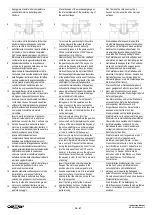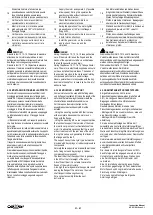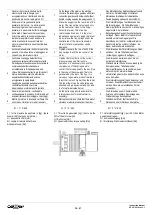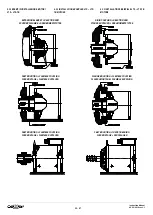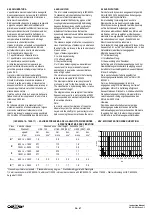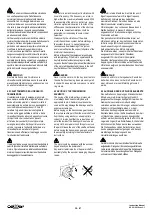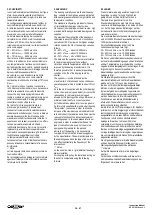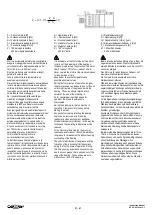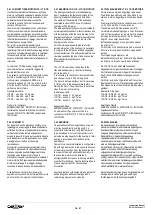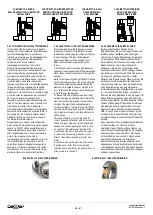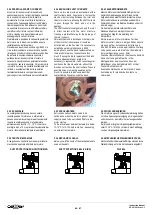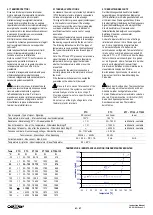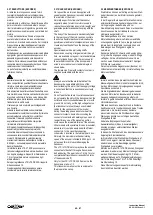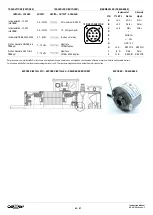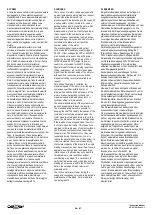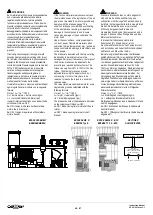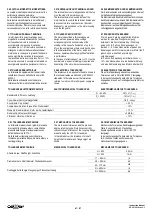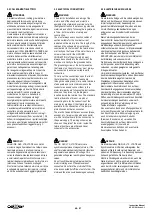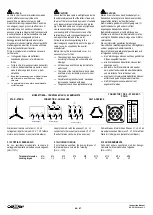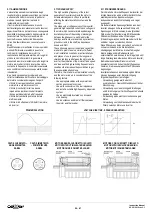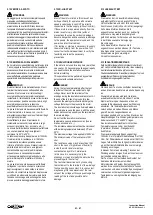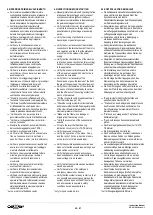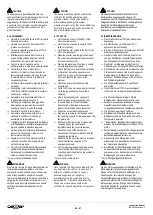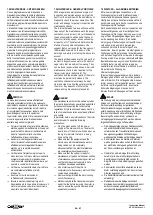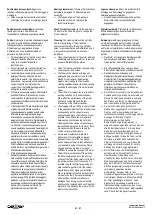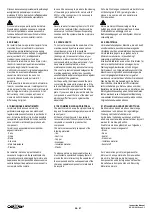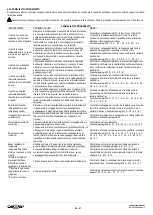
44 - 97
Instruction Manual
AC 02/2019-rev.1.1
5.3 FRENI
A richiesta alcune serie di motori possono essere
equipaggiate con freno elettromagnetico di
stazionamento. Se non diversamente precisato i
freni elettromagnetici adottati sono del tipo di
sicurezza a molle, idonei per utilizzo come
stazionamento e ad azione frenante per
mancanza di alimentazione. Normalmente il freno
è dimensionato in modo tale da fornire una
coppia statica inferiore o uguale a quella
nominale del motore. Tuttavia, data l’elevata
coppia sviluppata da alcune serie di motori il
freno talvolta non raggiunge i valori nominali del
motore.
L’elettromagnete è alimentato in cor
rente
continua e la tensione nominale standard è di 96
Vdc. Tensioni diverse (24Vdc o 200Vdc) sono
disponibili a richiesta. Di serie è fornito l’apposito
alimentatore con ingresso in corrente alternata a
220 V 50/60 Hz ed uscita a 96 V dc (per i freni a
24
Vdc non viene fornito l’alimentatore).
Modelli ed esecuzioni speciali per servizi gravosi
(sollevamento, emergenza, etc.) con coppie
superiori alla nominale del motore o con
accessori specifici (microinterruttori, leva di
sblocco manuale) sono disponibili a richiesta.
Note: Con l’applicazione del freno la velocità
massima del motore viene limitata ed anche Il
funzionamento in verticale in alcuni casi non è
consentito. Consultare le schede tecniche dei
motori, paragrafo freni, per verificare la velocità
max consentita ed eventualmente contattare il
ns. ufficio tecnico per maggiori dettagli.
La decelerazione/frenatura del sistema deve
avvenire in modo dinamico tramite l’inverter.
Il freno meccanico è idoneo unicamente per
mantenere bloccato l’albero motore n
elle pause
del ciclo e deve intervenire solo quando la
velocità di rotazione del motore è prossima allo
zero. In determinati casi il freno può anche
essere utilizzato per risolvere situazioni di
emergenza che richiedono di arrestare il carico
quando il motore è ancora in rotazione per
inerzia. Questo tipo di utilizzo può comportare un’
usura anche rapida del materiale d’attrito e
generare elevate temperature sui componenti del
freno. In nessun caso il freno deve essere
utilizzato ripetutamente durante il ciclo macchina
o per ridurre il tempo di decelerazione del
sistema. Per un corretto dimensionamento è
anche necessario verificare la capacità termica
del freno nel compiere una singola manovra di
frenatura. In alcune applicazioni con inerzie del
carico e velocità di rotazione elevate, il freno
potrebbe non essere in grado di completare la
frenata in condizioni di sicurezza senza
danneggiarsi. E’ necessario calcolare e verificare
che il lavoro compiuto dal freno durante la
manovra di frenatura non ecceda il dato di
catalogo Qmax (lavoro massimo ammissibile).
Il materiale di attrito è destinato ad usurarsi e di
conseguenza deve essere prevista una
manutenzione periodica del freno. Per maggiori
dettagli consultare il paragrafo 13.
5.3 BRAKES
Some series of motors can be equipped with
an electromagnetic parking brake on request.
Unless otherwise indicated, the
electromagnetic brakes used are the type with
a spring safety system, suitable for use as
parking brakes and to brake the motor when
powered down. Normally the brake is
dimensioned to provide a static torque lower
than or equal to the nominal value of the
motor. However, considering the high torque
developed by some series and size of motors,
sometimes the brake will not reach the
nominal values of the motor.
The electromagnet is powered by direct
current and the standard nominal voltage is
96 VDC. Other voltages (24VDC or 200VDC)
are available on request. A specific power
supply is provided with an AC input 220 V
50/60 Hz and a 96 VDC output (a power
supply is not provided for 24VDC brakes).
Special models for harsh working conditions
(lifting, emergency, etc.) with torque values
higher than the nominal value of the motor or
with specific accessories (microswitches,
manual unlocking levers) are available on
request.
Note: When the brake is installed, the
maximum speed of the motor is limited and in
some cases vertical installation is not
allowed. Consult the technical sheets of the
motors, brakes paragraph, to check the
maximum speed allowed and contact our
technical office for more details.
The deceleration/braking of the system must
be done dynamically through the inverter.
The mechanical brake is only suitable for
keeping the shaft blocked in the pauses of the
cycle and must only be activated when the
motor has almost stopped turning. In certain
cases, the brake can be used in emergencies
if the load has to be stopped when the motor
is still turning under inertia. This type of use
can lead to the rapid wear of contact surfaces
and the brake components can reach high
temperatures. The brake must not be used
repeatedly during the machine cycle or to
reduce the deceleration time of the system. In
order to establish the correct dimensioning,
the thermal capacity of the brake in the single
braking manoeuvres must be verified. In some
applications with high load inertia and high
rotation speed, the brake may not be able to
finish braking in safe conditions without
overheating or damage. It is necessary to
verify that the work done by the brake during
braking do not exceed within the limits of the
data in the catalogue Qmax (maximum
allowable work).
The friction material will wear during the
usage and consequently is required a periodic
maintenance of the brake. For more details
see paragraph 13.
5.3 BREMSEN
Einige Motorbaureihen können auf Anfrage mit
einer elektromagnetischen Feststellbremse
ausgerüstet werden. Bei den eingebauten
elektromagnetischen Bremsen handelt es sich,
sofern nicht anders angegeben, um Feder-
speicherbremsen, die als Feststellbremse und zum
Abbremsen bei Netzausfall geeignet sind. Die
Bremse ist in der Regel so ausgelegt, dass sie ein
statisches Drehmoment erzeugt, das kleiner oder
gleich dem Motornennmoment ist. Aufgrund des
von einigen Baureihen entwickelten hohen
Drehmoments erreicht die Bremse jedoch
manchmal nicht die Motornennwerte.
Der Elektromagnet wird mit Gleichstrom gespeist
und die Standardnennspannung beträgt 96 V
(Gleichstrom). Andere Spannungen (24 V oder
200 V Gleichstrom) sind auf Anfrage erhältlich.
Serienmäßig ist eine entsprechende Energiequelle
mit Wechselstromeingang 220 V 50/60 Hz und
Gleichstromausgang 96 V im Lieferumfang
enthalten (bei Bremsen mit 24 V Gleichstrom wird
keine Energiequelle geliefert).
Sondermodelle und -ausführungen für hohe
Beanspruchungen (Hubwerke, Not-Aus etc.) mit
höheren Drehmomenten als dem
Motornennmoment oder mit speziellem Zubehör
(Mikroschalter, manueller Lösehebel) sind auf
Anfrage erhältlich.
Hinweise: Durch das Anbringen der Bremse wird
die Höchstdrehzahl des Motors begrenzt. Auch ist
der Vertikalbetrieb in einigen Fällen nicht zulässig.
Für die zulässige Höchstdrehzahl siehe
Motordaten-blätter, Abschnitt Bremsen. Wenden
Sie sich für nähere Angaben gegebenenfalls an
unsere Konstruktionsabteilung.
Das Drosseln/Abbremsen des Systems muss
dynamisch durch den Inverter erfolgen.
Die mechanische Bremse dient nur zum Blockieren
der Antriebswelle während der Zykluspausen. Sie
darf nur eingreifen, wenn die Motordrehzahl nahe
bei Null liegt. In bestimmten Fällen, wenn die Last
angehalten werden muss, während der Motor
aufgrund der Trägheit noch ausläuft, kann die
Bremse auch als Notbremse benutzt werden. Wird
die Bremse derart eingesetzt, kann dies zu
(schnellem) Verschleiß des Reibstoffs und zu
hohen Temperaturen an den Bremsbauteilen
führen. Die Bremse darf während des
Maschinenzyklus keinesfalls wiederholt oder zum
schnelleren Abbremsen des Systems eingesetzt
werden. Zur korrekten Dimensionierung der
Bremse ist es auch erforderlich, die
Wärmekapazität der Bremse während eines
Bremsvorgangs zu überprüfen. Bei einigen
Anwendungen mit Lastträgheit und hohen
Drehzahlen ist die Bremse möglicherweise nicht
in der Lage, einen Bremsvorgang sicher zu Ende
zu bringen, ohne Schäden davonzutragen. Die
von der Bremse während eines Bremsvorgangs
zu erbringende Leistung ist zu berechnen. Ferner
muss überprüft werden, ob der errechnete Wert
Qmax (zulässige Höchstleistung) nicht
überschreitet.

